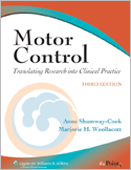Motor Control is the only text to bridge the gap between current
motor control research and its applications to clinical practice. It
gives you a full arsenal of best-evidence tools and information to
examine, diagnose, and treat patients who have problems with balance,
mobility, and upper extremity function.
After a review of the latest theories of motor control, motor
learning, and recovery of function, students are provided with a
conceptual framework for clinical practice and a practical framework
for understanding and examining impairments in patients with
neurological deficits. Armed with a solid foundation, students then
build a thorough understanding of motor control issues as they relate
to posture and balance, mobility, and upper extremity function. For
each of these three key areas, the authors discuss normal control
processes, age-related issues, abnormal function, and the clinical
applications of current research.
New to this Third Edition?
Two-color design and updated art program engage readers and
illuminate content.
Latest research findings and their clinical applications in postural
control, mobility, and upper extremity function provide the most up-
to-date information on new advances in the field.
Learning objectives and answer keys included in each chapter enhance
learning.
More Highlights and Features?
Assessment and treatments are classified into impairment levels,
strategy levels, and functional levels for easy reference.
Drawings, charts, tables, and photographs help students visualize and
better understand postural control and functional mobility.
Laboratory activities and case studies reinforce and apply key
concepts to patients with different diagnoses.
In recent years, there have been tremendous leaps in motor control
research. Now you have the best-evidence tools to fully utilize this
research for your own practice!


